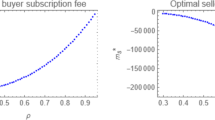Abstract
In this article we analyze asymmetric two-sided markets. Two types of agents are assumed to interact with each other and we assume that agents of one type derive utility from inter-group interactions, while the other type of agents benefit from intra-group rather than from inter-group interactions as it is assumed in the standard symmetric two-sided markets model. First, we consider a monopoly platform, then we analyze competing platforms, both with single-homing and multi-homing abilities.

Similar content being viewed by others
Notes
For example, one may think of group 1 as the users of a social media platform and of group 2 as firms that advertise/sell on the platform. Obviously users derive benefit from being able to interact with more users, while an advertiser ultimately cares only about the number of users who use the platform.
Modeling demands as functions of utilities has the consequence that prices are implicitly determined by equations given in Assumption 1.
To simplify notation generally we do not write out the independent variables of ηi(⋅) and we will mention them only when it is necessary to prevent misunderstanding.
Alternatively, this assumption could be substituted with an assumption about the existence of a large intrinsic value, \({v_{i}^{0}}\), an agent of type i = 1, 2 receives by joining a platform, as it is in e.g. Armstrong and Wright (2006).
For more on regulation on two-sided markets see Frieden (2017).
References
Armstrong M (2006) Competition in two-sided markets. RAND J Econ 37 (3):668–691
Armstrong M, Wright J (2006) Two-sided markets, competitive bottlenecks and exclusive contracts. Economic Theory 32(2):353–380
Frieden R (2017) The internet of platforms and two-sided markets: legal and regulatory implications for competition and consumers. SSRN Electronic Journal. https://doi.org/10.2139/ssrn.3051766
Hagiu A, Halaburda H (2014) Information and two-sided platform profits. Int J Ind Organ 34:25–35
Rochet JC, Tirole J (2003) Platform competition in two-sided markets. J Eur Econ Assoc 1(4):990–1029
Vasconcelos H (2015) Is exclusionary pricing anticompetitive in two-sided markets?. Int J Ind Organ 40:1–10
Weyl EG (2010) A price theory of multi-sided platforms. Am Econ Rev 100:1642–1672
Acknowledgments
The first author gratefully acknowledges financial support from the Hungarian National Research, Development and Innovation Office (NKFI-119930) and from the Hungarian Academy of Sciences (MTA) through the Bolyai János Research Scholarship.
Author information
Authors and Affiliations
Corresponding author
Rights and permissions
About this article
Cite this article
Bakó, B., Fátay, D. Platform Competition with Intra-Group Externalities. J Ind Compet Trade 19, 141–154 (2019). https://doi.org/10.1007/s10842-018-0282-7
Received:
Revised:
Accepted:
Published:
Issue Date:
DOI: https://doi.org/10.1007/s10842-018-0282-7




